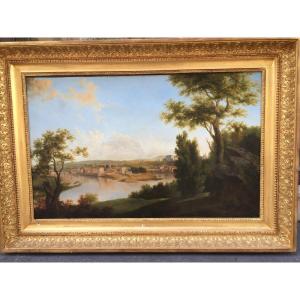Oil on panel VB monogrammed, Circa 1830
In a frame of the same time.
Size:
56 x 90 cm without frame.
76 x 108 cm with frame.
Jean-Victor Bertin (1767-1842) was a French landscape painter of the neoclassical school. Considered one of the masters of the school of historical landscape, he painted an abundant production inspired by Italy.
Born on March 20, 1767 in Paris, Jean-Victor Bertin was a pupil of Pierre-Henri de Valenciennes. He is the son of a barber master (Like his master Valenciennes and his pupil Corot).
In 1785, at age 18, he entered the Royal Academy of Painting and Sculpture, as a student of Gabriel François Doyen. In 1788 he enrolled as a pupil of Valenciennes. (He will present at the show as his student until 1840). Between 1785 and 1793, he participated in various emulation contests. From 1793, he exhibited regularly at the Salon until his death. He received an incentive award in 1799 and his work is praised by a gold medal of the first class in 1808. He was awarded the Legion of Honor on 21 August 1822.
He has certainly made the traditional trip to Italy between 1806 and 1810. Its outdoor executed landscapes are mostly recomposed in the workshop according to the rules of classic design inherited from Poussin.
Leading the landscape compound, he is behind the creation of the Prix de Rome for historical landscape that he proposed to the Academy in 1801, and which his master Valenciennes get the foundation in 1816. Number of winners of this award were Bertin students, starting with Michallon, the first of the list to receive this prestigious award. The reputation of the Bertin workshop is such that it will be attended by two generations of artists and it has generated most landscape vocations during the first half of the nineteenth century.
His many students include Boisselier, Buttura, Coignet, Corot, De Laberge, Childish, Fleury, Jolivard, Lanoue, Remond, Ricahrd ...
Heir to the teaching of Valenciennes, he also transmits the publishing course landscape illustrated with lithographs: landscapes Studies (1823), Collection of landscape studies since 1816, and Compilation of tree studies (from 1811 to 1821 ).
He is one of the most talented representatives of the landscape "adjusted" Italianate character and elegiac.
With his master, he shares the characteristics that will be those of the School of the historic landscape: spreading plans supported by a cleverly distributed light. The pallet is smooth and favors a range of greens and blues. The foliage often wispy, painted a meticulous brush. This refinement in the execution results in a smooth and porcelainée bill.
He plays the role of intermediary between the historic landscape and romantic movement.
Bertin renown and fame under the Empire and the Restoration brings him prestigious private clients. His talent was appreciated by leading amateurs, such as the Duke of Berry or the banker Jacques Laffitte. Several works were also commissioned to him for the Trianon Palace and the Castle of Fontainebleau between 1811 and 1817. From 1833, the State regularly bought his works, especially the Ministry of Interior to enrich museums province.
His work is in museums of Beziers, Fontainebleau, Dijon, Honfleur, Rennes, Versailles, Angers, Autun, Carpentras, Cherbourg, Coutances, Evreux, La Fere, Lille, Quimper, Nantes, Reims, Rouen, Toulouse.
Bibliography:
Dictionary French landscape painters of the nineteenth century, Lydia Harambourg.
Dictionary of the Little Masters of Painting 1820-1920, Gérald Schurr and Pierre Cabane.


































 Le Magazine de PROANTIC
Le Magazine de PROANTIC TRÉSORS Magazine
TRÉSORS Magazine Rivista Artiquariato
Rivista Artiquariato